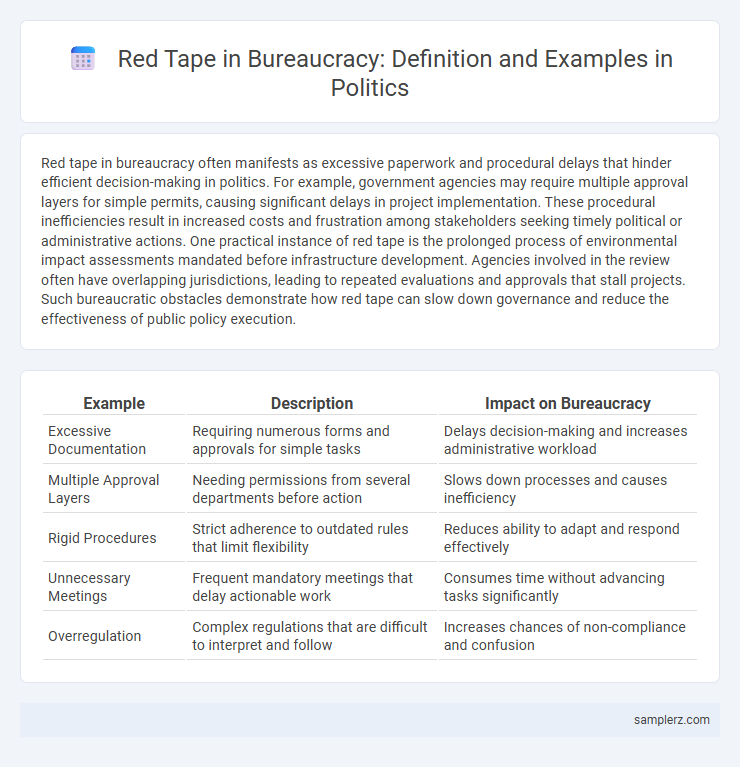Red tape in bureaucracy often manifests as excessive paperwork and procedural delays that hinder efficient decision-making in politics. For example, government agencies may require multiple approval layers for simple permits, causing significant delays in project implementation. These procedural inefficiencies result in increased costs and frustration among stakeholders seeking timely political or administrative actions. One practical instance of red tape is the prolonged process of environmental impact assessments mandated before infrastructure development. Agencies involved in the review often have overlapping jurisdictions, leading to repeated evaluations and approvals that stall projects. Such bureaucratic obstacles demonstrate how red tape can slow down governance and reduce the effectiveness of public policy execution.
Table of Comparison
| Example | Description | Impact on Bureaucracy |
|---|---|---|
| Excessive Documentation | Requiring numerous forms and approvals for simple tasks | Delays decision-making and increases administrative workload |
| Multiple Approval Layers | Needing permissions from several departments before action | Slows down processes and causes inefficiency |
| Rigid Procedures | Strict adherence to outdated rules that limit flexibility | Reduces ability to adapt and respond effectively |
| Unnecessary Meetings | Frequent mandatory meetings that delay actionable work | Consumes time without advancing tasks significantly |
| Overregulation | Complex regulations that are difficult to interpret and follow | Increases chances of non-compliance and confusion |
Classic Red Tape Scenarios in Government Agencies
Classic red tape scenarios in government agencies include excessive paperwork requirements, multiple layers of approval, and rigid adherence to outdated regulations that delay service delivery. Public sector employees often face strict protocols that hinder swift decision-making, such as mandatory forms for routine tasks and prolonged compliance checks. These bureaucratic obstacles reduce operational efficiency and frustrate citizens awaiting timely government assistance.
Red Tape in Public Sector Hiring Processes
Lengthy documentation requirements and multiple approval layers often delay public sector hiring, exemplifying red tape in bureaucracy. Candidates may face prolonged waiting periods due to strict compliance checks and cumbersome background verification procedures. Such inefficiencies hinder timely recruitment, impacting government operational effectiveness and service delivery.
Licensing and Permit Delays: Bureaucratic Obstacles
Lengthy processing times for business licenses and construction permits often highlight bureaucratic red tape, causing significant delays that hinder economic growth. Complex regulatory requirements and multiple layers of approval contribute to prolonged waiting periods, frustrating entrepreneurs and developers. These administrative bottlenecks reduce operational efficiency and deter investment by increasing costs and uncertainty.
Regulatory Compliance: Layers of Administrative Red Tape
Regulatory compliance often involves navigating multiple layers of administrative red tape, including extensive paperwork, repetitive approvals, and stringent procedural requirements that delay project implementation. For example, environmental permits may require sequential reviews by local, state, and federal agencies, each with unique regulations and timelines. This complex bureaucracy frequently hinders efficient governance and increases operational costs for public and private sector initiatives.
Social Welfare Application Complexities
Social welfare application processes often involve excessive red tape, requiring applicants to submit extensive documentation multiple times, causing delays and frustrations. Complex eligibility criteria and lengthy verification procedures create barriers for vulnerable populations seeking timely assistance. Streamlining these bureaucratic hurdles is essential to improving access and efficiency in social welfare programs.
Healthcare System Bureaucratic Inefficiencies
Healthcare system bureaucratic inefficiencies often manifest as excessive paperwork requirements, leading to delayed patient care and increased administrative costs. Lengthy authorization processes for treatments and referrals create significant obstacles for both healthcare providers and patients. These bureaucratic hurdles contribute to resource misallocation and diminished overall healthcare quality.
Infrastructure Projects Stalled by Red Tape
Infrastructure projects often face significant delays due to bureaucratic red tape, which includes excessive permits, complicated approval processes, and overlapping regulatory requirements. These administrative hurdles inflate costs and stall essential developments such as highway expansions, public transit systems, and water treatment facilities. Streamlining regulations and improving interagency coordination are critical to accelerating project completion and promoting economic growth.
Education Policies Hampered by Bureaucratic Procedures
Complex bureaucratic protocols significantly delay the implementation of education policies, restricting timely improvements in curriculum and resource allocation. Lengthy approval processes and extensive paperwork hinder schools from adapting to new educational standards or receiving necessary funding efficiently. Such administrative red tape obstructs the delivery of quality education and impedes policy responsiveness to evolving student needs.
Small Business Challenges with Government Red Tape
Small businesses often face significant challenges due to government red tape, including excessive paperwork and complex permit requirements that delay project launches and increase operating costs. Regulatory compliance demands can divert critical resources from core business activities, hindering growth and innovation. Navigating these bureaucratic obstacles reduces competitiveness and intensifies financial strain for small entrepreneurs.
Immigration and Visa Processing Bureaucracy
Immigration and visa processing often exemplify red tape through lengthy document verification, multiple approval layers, and rigid procedural requirements that delay application outcomes. Applicants face extensive background checks, redundant paperwork, and mandatory interviews, which collectively hinder timely entry approvals. These bureaucratic obstacles strain resources and create inefficiencies within government immigration agencies.

example of red tape in bureaucracy Infographic
 samplerz.com
samplerz.com